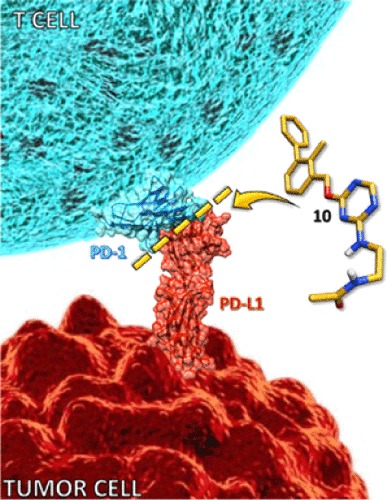当前位置:
X-MOL 学术
›
J. Med. Chem.
›
论文详情
Our official English website, www.x-mol.net, welcomes your
feedback! (Note: you will need to create a separate account there.)
Interfering with the Tumor–Immune Interface: Making Way for Triazine-Based Small Molecules as Novel PD-L1 Inhibitors
Journal of Medicinal Chemistry ( IF 6.8 ) Pub Date : 2021-10-20 , DOI: 10.1021/acs.jmedchem.1c01409 Pasquale Russomanno 1 , Giulia Assoni 2, 3 , Jussara Amato 1 , Vincenzo Maria D'Amore 1 , Riccardo Scaglia 3 , Diego Brancaccio 1 , Martina Pedrini 3 , Giovanna Polcaro 4 , Valeria La Pietra 1 , Paolo Orlando 3 , Marianna Falzoni 3 , Linda Cerofolini 5 , Stefano Giuntini 5 , Marco Fragai 5 , Bruno Pagano 1 , Greta Donati 1 , Ettore Novellino 6 , Cristina Quintavalle 7 , Gerolama Condorelli 7, 8 , Francesco Sabbatino 4 , Pierfausto Seneci 3 , Daniela Arosio 9 , Stefano Pepe 4 , Luciana Marinelli 1
Journal of Medicinal Chemistry ( IF 6.8 ) Pub Date : 2021-10-20 , DOI: 10.1021/acs.jmedchem.1c01409 Pasquale Russomanno 1 , Giulia Assoni 2, 3 , Jussara Amato 1 , Vincenzo Maria D'Amore 1 , Riccardo Scaglia 3 , Diego Brancaccio 1 , Martina Pedrini 3 , Giovanna Polcaro 4 , Valeria La Pietra 1 , Paolo Orlando 3 , Marianna Falzoni 3 , Linda Cerofolini 5 , Stefano Giuntini 5 , Marco Fragai 5 , Bruno Pagano 1 , Greta Donati 1 , Ettore Novellino 6 , Cristina Quintavalle 7 , Gerolama Condorelli 7, 8 , Francesco Sabbatino 4 , Pierfausto Seneci 3 , Daniela Arosio 9 , Stefano Pepe 4 , Luciana Marinelli 1
Affiliation

|
The inhibition of the PD-1/PD-L1 axis by monoclonal antibodies has achieved remarkable success in treating a growing number of cancers. However, a novel class of small organic molecules, with BMS-202 (1) as the lead, is emerging as direct PD-L1 inhibitors. Herein, we report a series of 2,4,6-tri- and 2,4-disubstituted 1,3,5-triazines, which were synthesized and assayed for their PD-L1 binding by NMR and homogeneous time-resolved fluorescence. Among them, compound 10 demonstrated to strongly bind with the PD-L1 protein and challenged it in a co-culture of PD-L1 expressing cancer cells (PC9 and HCC827 cells) and peripheral blood mononuclear cells enhanced antitumor immune activity of the latter. Compound 10 significantly increased interferon γ release and apoptotic induction of cancer cells, with low cytotoxicity in healthy cells when compared to 1, thus paving the way for subsequent preclinical optimization and medical applications.
中文翻译:

干扰肿瘤免疫界面:让基于三嗪的小分子作为新型 PD-L1 抑制剂让路
单克隆抗体对 PD-1/PD-L1 轴的抑制在治疗越来越多的癌症方面取得了显著成功。然而,以 BMS-202 ( 1 ) 为先导的一类新型有机小分子作为直接 PD-L1 抑制剂正在兴起。在这里,我们报告了一系列 2,4,6-三和 2,4-二取代的 1,3,5-三嗪,它们被合成并通过 NMR 和均匀的时间分辨荧光测定其 PD-L1 结合。其中,化合物10与 PD-L1 蛋白强烈结合,并在表达 PD-L1 的癌细胞(PC9 和 HCC827 细胞)和外周血单核细胞的共培养中对其进行挑战,增强了后者的抗肿瘤免疫活性。化合物10显着增加干扰素γ释放和癌细胞的凋亡诱导,与1相比,在健康细胞中具有较低的细胞毒性,从而为后续的临床前优化和医学应用铺平了道路。
更新日期:2021-11-11
中文翻译:

干扰肿瘤免疫界面:让基于三嗪的小分子作为新型 PD-L1 抑制剂让路
单克隆抗体对 PD-1/PD-L1 轴的抑制在治疗越来越多的癌症方面取得了显著成功。然而,以 BMS-202 ( 1 ) 为先导的一类新型有机小分子作为直接 PD-L1 抑制剂正在兴起。在这里,我们报告了一系列 2,4,6-三和 2,4-二取代的 1,3,5-三嗪,它们被合成并通过 NMR 和均匀的时间分辨荧光测定其 PD-L1 结合。其中,化合物10与 PD-L1 蛋白强烈结合,并在表达 PD-L1 的癌细胞(PC9 和 HCC827 细胞)和外周血单核细胞的共培养中对其进行挑战,增强了后者的抗肿瘤免疫活性。化合物10显着增加干扰素γ释放和癌细胞的凋亡诱导,与1相比,在健康细胞中具有较低的细胞毒性,从而为后续的临床前优化和医学应用铺平了道路。











































 京公网安备 11010802027423号
京公网安备 11010802027423号